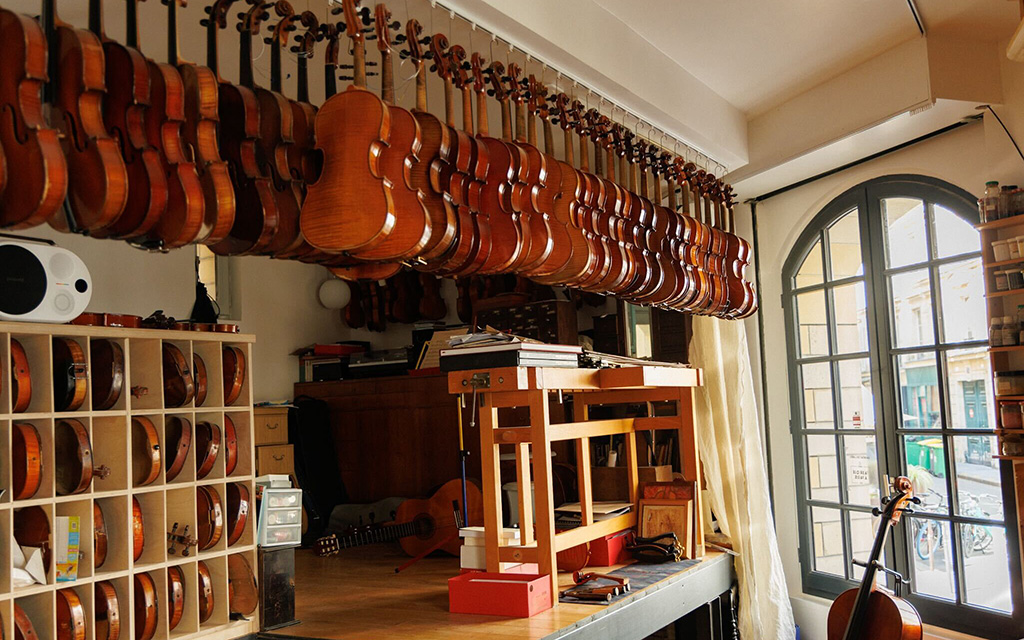
The view from one of the 70 housing units at the Caserne des Minimes affordable housing projects that was once used as military barracks (Photo by Savannah Bowie/Special for Cronkite News)

Resident Emmanuelle Fayat’s violin workshop (Atelier de lutherie) where she repairs, makes and restores string instruments. The workshop is located in the Caserne des Minimes affordable housing projects. (Photo by Savannah Bowie/Special for Cronkite News)
PARIS – Under the spotlight of the Olympic Games, Paris’ attempt to keep middle- and lower-income residents in the heart of the city has taken center stage as concerns about gentrification grow.
One of the densest cities in the world, Paris has spent the past 20 years working to increase housing for those in need through public housing and protect residents from rising rental prices.
Parisian homeowners leaving their properties empty for much of the year or turning them into short-term rentals for tourists have complicated the issue. The government is focused on tighter regulations, including city approval requirements for Airbnb-type rentals, which are now restricted to short periods.
The city is also focused on lowering montly costs.
“Rent capping was the very first system we put in place … we are the only city in France to have control over rent,” said Barbara Gomes, delegate counselor in charge of rent control, rental platforms and tenant protection.
Her focus is to establish a cap that limits rent increases, calculating the maximum allowable rent.
“We have only had this for a year and a half, and we are proud of what it has accomplished,” Gomes said.
Paris also hosts an event called Night of Solidarity, where Parisians volunteer to help track the homeless population while officials evaluate the effectiveness of their initiatives.
“Parisian people come to count homeless people but also get to meet them,” said Christine Lalonde, general director of the Régie immobilière de la ville de Paris, a public housing agency created in 1923 for the construction of low cost and affordable housing in the city.
The event raises awareness of people living on the streets and allows them to share their stories.
One of the largest initiatives is the construction of public housing with a goal of providing affordable accommodations for lower-income families, artisans and students. There are 1.4 million such units, making up 25% of the housing in Paris.
“Social housing is for life in Paris,” said Anne-Katrin Le Doeuff, director of AORIF, a union serving social housing organizations in France.
Caserne des Minimes is an example of how social housing in the high-end Marais district has been converted into an open, green space, a zone of preservation and community. This public space has become an urban oasis, providing a haven for the 70 public housing units and artisan workshops surrounding it.
Margaux Fournier, an art student living in Caserne des Minimes, shares her apartment with three other roommates she did not previously know.

The central courtyard and green space located at the Caserne des Minimes affordable housing projects. Used as a city oasis for entertainment and enchantment (Photo by Savannah Bowie/Special for Cronkite News)
“As an artist, it’s complicated to get started,” said Fournier, who added that the low cost of housing allows her to focus on her studies and art while alleviating financial stress.
The housing also supports artists in specialized crafts. Emmanuelle Fayat, a violin-maker and restorer, has a workshop in Caserne des Minimes. Fayat, who is believed to be one of only two violin-makers in Paris, emphasized the financial pressures faced by artisans. The stability of having a dedicated workshop space allows her to focus on her craft.
Now all eyes are on the housing in the Olympic Village and what will become of it after the Games.
“The Olympic Village creates housing in an area where there didn’t used to be buildings,” said Jacques Baudrier, deputy mayor of Paris in charge of housing and the ecological transition of buildings. “Of course, it’s a positive thing, but there are negative aspects. … It doesn’t make up for the housing that needs to be built.”
The Olympic Village is under particular scrutiny because it was build in one of Paris’ poorest suburbs, and many who lived in street encampments or abandoned buildings were shipped out of the city, the New York Times reported.
With initiatives including Night of Solidarity, rent capping and public housing, the Paris government’s efforts have noticeably improved housing conditions, also it, like many cities, continue to struggle with a homeless problem.
Ensuring that no housing remains vacant for extended periods and utilizing available housing are strategies that could be beneficial in other regions, such as Arizona.
Arizona and Paris sometimes share extreme heat conditions during the summer.
“In the event of a heatwave and high temperatures, as we might face next week, significant health risks can particularly affect vulnerable people,” Baudrier said.
“If there had been a gold medal for renovating social housing, we would have won it by now.”